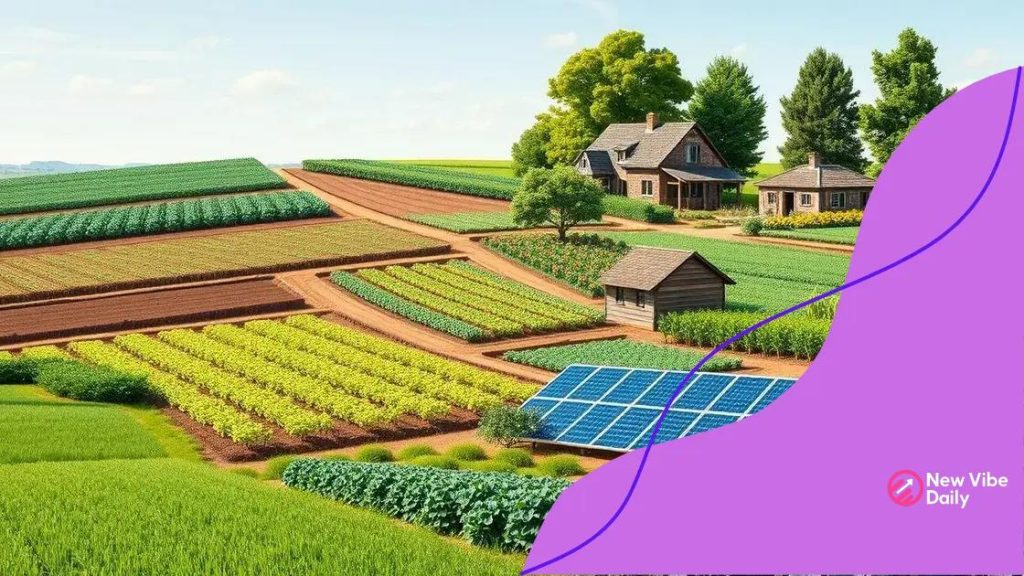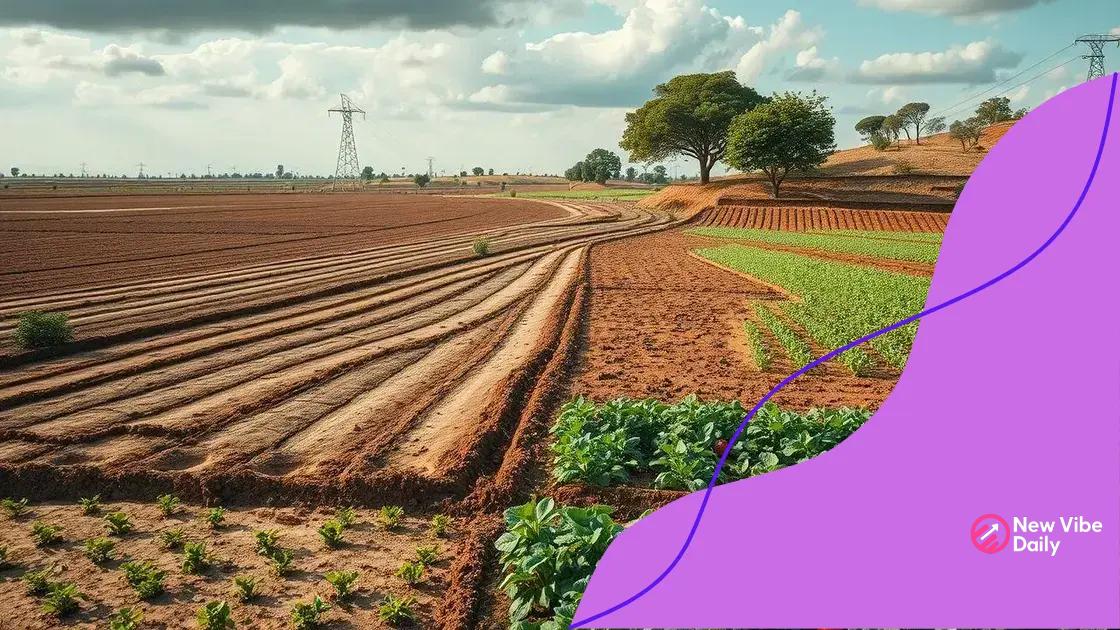Developments in sustainable agriculture practices

Connecting consumers with sustainable farming fosters awareness and supports local economies while encouraging farmers to adopt eco-friendly practices, ultimately creating a healthier food system.
Developments in sustainable agriculture practices are changing the landscape of farming. Have you ever wondered how these changes could impact our food system and environment? In this article, we’ll delve into exciting advancements that promise to reshape agricultural methods for the better.
Understanding sustainable agriculture
Understanding sustainable agriculture is essential for a healthier planet. It involves practices that not only meet our food needs but also ensure that future generations can thrive. This approach emphasizes the use of methods that are kind to the environment, promote biodiversity, and support local economies.
Core Principles of Sustainable Agriculture
Sustainable agriculture rests on several fundamental principles. These principles guide farmers in making choices that benefit their land and local communities. Here are some key aspects:
- Soil Health: Maintaining soil fertility through crop rotation and organic fertilizers is critical.
- Water Conservation: Efficient irrigation techniques help conserve water while maximizing yield.
- Biodiversity: Encouraging a variety of plants and animals supports ecosystem balance.
By understanding these principles, farmers can implement strategies that enhance productivity while minimizing harm. Another important aspect is the reliance on local resources, which strengthens community ties and reduces the carbon footprint.
Practices in Sustainable Agriculture
Much of sustainable agriculture is about choosing practices that work in harmony with nature. Techniques such as integrated pest management (IPM) involve using natural predators to control pests instead of harmful chemicals. This reduces environmental impact and promotes healthier crops.
Additionally, the use of cover crops helps prevent soil erosion, enriches the soil, and retains moisture. Farmers are also exploring permaculture, a design system that relies on creating sustainable and self-sufficient agricultural ecosystems. These practices not only nourish the soil but also foster a vibrant local ecosystem.
As we learn more about the benefits of sustainable agriculture, it becomes clear that these methods can lead to healthier food systems and restored ecosystems. Engaging consumers in understanding where their food comes from can create a demand for sustainable practices. This connection empowers families and communities to support local farmers who are committed to preserving the land.
Embracing sustainable agriculture can lead to a revolution in the farming industry, ensuring that practices today do not compromise the ability of future generations to enjoy the same resources.
Innovative techniques in crop management
Innovative techniques in crop management are transforming how farmers approach agriculture today. These techniques not only maximize yields but also promote sustainability. By adopting new strategies, farmers can increase efficiency while caring for the environment.
Key Techniques
Farmers are utilizing various advancements to enhance crop management practices. Some of the most effective methods include:
- Precision Agriculture: This technique uses technology like GPS and data analytics to monitor crop health and soil conditions, allowing for more targeted interventions.
- Integrated Pest Management (IPM): IPM combines biological controls, cultural practices, and chemical methods in an environmentally safe way to manage pests.
- Crop Rotation: Rotating crops helps to improve soil fertility and reduce pest buildup, sustaining the ecosystem.
Through these innovative techniques, farmers can achieve better output while minimizing waste. Technologies such as drones and soil sensors provide real-time data to make informed decisions, further enhancing productivity.
Benefits of Innovative Techniques
The benefits of these techniques go beyond just higher yields. They support overall farm sustainability and resilience against climate change. By adopting practices like cover cropping and conservation tillage, farmers can improve soil health and sequester carbon. This not only helps in the fight against climate change but also ensures long-term viability for farming communities.
Utilizing technology not only streamlines management but also provides farmers with tools to adapt to changing environmental conditions. This innovation leads to the ability to respond quickly to challenges, like a sudden pest outbreak or a drought. Farmers who embrace these methods become future leaders in sustainable agriculture.
As agriculture continues to evolve, the embrace of innovative crop management techniques will be vital for meeting the food demands of a growing population while protecting our natural resources.
Impact of climate change on farming practices

The impact of climate change on farming practices is significant and far-reaching. Farmers are noticing changes in weather patterns, leading to uncertainties in crop production. As temperatures rise and precipitation becomes more unpredictable, it is crucial to understand how these changes affect agriculture.
Effects of Climate Change
Several key effects of climate change are reshaping how farmers operate. These include:
- Increased temperatures: Higher temperatures can lead to heat stress in plants, reducing yields.
- Altered rainfall patterns: Some regions experience droughts while others face flooding, which can damage crops.
- Pest and disease pressure: Warmer climates may lead to an increase in pests and diseases, threatening crops and livestock.
These effects create a challenging environment for farmers. Each season poses new risks that can complicate planning and management. Farmers must adapt by changing the way they grow crops and raise livestock.
Adaptive Strategies
To combat the effects of climate change, many farmers are adopting innovative strategies. Some of these practices include:
- Drought-resistant crops: Planting varieties that can thrive in low water conditions helps maintain productivity.
- Improved irrigation techniques: Drip irrigation systems target water directly to the plants, conserving resources.
- Agroforestry: Integrating trees into farming systems can boost biodiversity and improve soil quality.
By implementing these adaptive measures, farmers can enhance resilience against the ongoing impacts of climate change. Collaboration among farmers, researchers, and policymakers is vital in sharing knowledge and resources. This holistic approach fosters resilience in farming communities.
Understanding the impact of climate change on farming practices is essential for ensuring a sustainable food supply. It highlights the necessity for continuous adaptation and innovation in agriculture.
The role of technology in sustainability
The role of technology in sustainability is becoming increasingly vital in today’s world. As we face environmental challenges, innovative technological solutions are helping to create sustainable practices in agriculture and beyond. These advancements not only boost efficiency but also support ecological balance.
Types of Technology in Sustainable Farming
Different types of technologies are being used to promote sustainability in agriculture. Some key technologies include:
- Sensor Technology: Sensors in fields monitor soil moisture and nutrients, allowing precise water and fertilizer application.
- Drones: Drones are used for aerial imaging and monitoring crop health, enabling farmers to make better decisions.
- Data Analytics: Data collection and analysis help in predicting yields and making informed management decisions.
These technologies provide farmers with tools to optimize resources and improve crop management. By using real-time data, farmers can tailor their operations to the specific needs of their crops, ultimately increasing productivity.
Benefits of Technological Innovation
The benefits of incorporating technology into sustainable practices are manifold. For example, using precision agriculture leads to reduced waste of water and fertilizers, which is essential for protecting natural resources. Furthermore, technology enhances the ability to respond to climate change by allowing farmers to adapt to shifting weather patterns.
Moreover, innovative technologies foster greater biodiversity by supporting diverse farming methods. Techniques like vertical farming and hydroponics utilize space and resources efficiently, providing fresh produce while minimizing land use.
As farmers adopt these advanced technologies, they can improve not only their own economic viability but also contribute to the overall health of the environment. The integration of technology in sustainability represents a significant step forward in promoting a balanced ecosystem and ensuring food security for future generations.
Connecting consumers with sustainable farming
Connecting consumers with sustainable farming is crucial for promoting environmentally friendly practices. By building a strong relationship between farmers and consumers, we can create a demand for more sustainable food options. This connection helps consumers understand where their food comes from and the benefits of supporting sustainable agriculture.
Importance of Consumer Awareness
Consumer awareness plays a vital role in the success of sustainable farming. When people know about the positive impact of their food choices, they are more likely to support local and sustainable farms. Awareness encourages consumers to ask questions about food sources and demand more transparency from producers.
- Informed Choices: Consumers can make better decisions when they understand the environmental and health benefits of sustainable practices.
- Support for Local Farms: Buying locally grown food supports the local economy and reduces carbon footprints.
- Healthy Eating: Sustainable farming often leads to fresher, more nutritious food options.
As consumers become more aware of these issues, they can influence market trends. Their choices can push more farmers to adopt sustainable practices, ultimately benefiting the planet.
Ways to Connect Consumers and Farmers
There are many effective ways to bridge the gap between consumers and sustainable farmers. Community-supported agriculture (CSA) programs are a popular method, allowing consumers to purchase shares of a farm’s harvest. This model not only provides fresh produce but also fosters a direct connection between consumers and farmers.
Farmers’ markets are another great way to enhance this relationship. At these markets, consumers can meet the people who grow their food, ask questions, and learn about their farming methods. Additionally, farm tours and workshops provide opportunities for people to experience sustainable farming practices firsthand.
Furthermore, online platforms and social media can serve as valuable tools in connecting consumers with sustainable farming. Farmers can showcase their practices, share their stories, and engage with consumers through blogs and social media posts, enhancing visibility and awareness.
By fostering these connections, we empower consumers to make choices that positively impact the environment and support sustainable practices. Together, consumers and farmers can contribute to a healthier and more sustainable food system.
FAQ – Frequently Asked Questions about Connecting Consumers with Sustainable Farming
Why is it important to connect consumers with sustainable farming?
Connecting consumers with sustainable farming raises awareness about eco-friendly practices and helps create a demand for healthier food choices.
How can consumers support local farmers?
Consumers can support local farmers by purchasing their products at farmers’ markets or through community-supported agriculture (CSA) programs.
What are the benefits of buying locally grown food?
Buying locally supports the local economy, reduces carbon footprints, and typically provides fresher produce with higher nutritional value.
How does consumer awareness impact farming practices?
Increased consumer awareness encourages farmers to adopt sustainable practices, ultimately leading to a healthier food system and environment.






